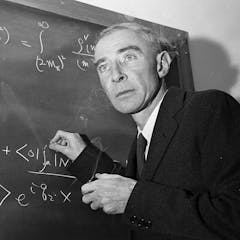
Articles on Atoms
Displaying 1 - 20 of 36 articles

Three scientists won the 2023 Nobel Prize in physics for their work developing methods to shoot laser pulses that only last an attosecond, or a mind-bogglingly tiny fraction of a second.

Remember building model molecules with balls and sticks in chemistry class? You have J. Robert Oppenheimer to thank for that, as a quantum chemist explains.

A biologist explains how researchers nail down the age of ancient fossils thanks to a physical process called radioactive decay.

A physicist explains how atoms arrange themselves into molecules – and how scientists are able to image these tiny bits of matter that make up everything around you.

Nuclear isomers are rare versions of elements with properties that mystified physicists when first discovered. Isomers are now used in medicine and astronomy, and researchers are set to discover thousands more of them.

Chinese American physicist Wu worked on the Manhattan Project and performed groundbreaking experiments throughout her long career.

Physicists can use bright, hot lasers to slow atoms down so much that they measure -459 degrees Fahrenheit.

The laws and principles of chemistry seem pretty set in stone. But as a chemist explains, the field is always evolving, including such fundamental principles as what is a chemical bond.

The movies make it seem like someday we’ll be able to make people and objects grow really big or shrink really small. Whether this will be possible comes down to the smallest of things.

Electricity happens when electrons move from one atom to another.

Entanglement is the mysterious relationship between two connected atoms. This relationship is the basis of quantum physics, but what is it exactly?

There are three ways heat can be shared: conduction, convection and radiation. Find out which one lets heat travel through space.

Left off publications due to Nazi prejudice, this Jewish woman lost her rightful place in the scientific pantheon as the discoverer of nuclear fission.

Alongside their famous dangers, radioactive materials have many beneficial uses. With as many more predicted as have already been discovered, nuclear physicists are searching for more isotopes.

Chemists sure know how to party. And here is the proof. On October 23rd they celebrate their hallowed unit: the mole. Find out what that’s all about.

Put simply, it’s the outcome of a chemical reaction, which humans learned how to make some 400,000 years ago.

Cosmologists are heading back to their chalkboards as the experiments designed to figure out what this unknown 84 percent of our universe actually is come up empty.

Canada is a world leader in the field of neutron scattering, winning a Nobel Prize in 1994 for its invention. But the looming shutdown of facilities at Chalk River puts us on the sidelines.

How do anesthetics work, and what makes for an ideal anesthetic? It’s not as mysterious as once believed, and there’s a gas that ticks all the boxes for a perfect anesthetic: xenon.

Work to develop a single-atom magnet that works at room temperature has just taken a big leap forward.
